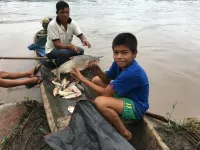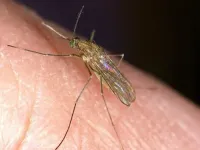(Press-News.org) A new study of dozens of wild fish species commonly consumed in the Peruvian Amazon says that people there could suffer major nutritional shortages if ongoing losses in fish biodiversity continue. Furthermore, the increasing use of aquaculture and other substitutes may not compensate. The research has implications far beyond the Amazon, since the diversity and abundance of wild-harvested foods is declining in rivers and lakes globally, as well as on land. Some 2 billion people globally depend on non-cultivated foods; inland fisheries alone employ some 60 million people, and provide the primary source of protein for some 200 million. The study appears this week in the journal Science Advances.
The authors studied the vast, rural Loreto department of the Peruvian Amazon, where most of the 800,000 inhabitants eat fish at least once a day, or an average of about 52 kilograms (115 pounds) per year. This is their primary source not only of protein, but fatty acids and essential trace minerals including iron, zinc and calcium. Unfortunately, it is not enough; a quarter of all children are malnourished or stunted, and more than a fifth of women of child-bearing age are iron deficient.
Threats to Amazon fisheries, long a mainstay for both indigenous people and modern development, are legion: new hydropower dams that pen in big migratory fish (some travel thousands of miles from Andes headwaters to the Atlantic estuary and back); soil erosion into rivers from deforestation; toxic runoff from gold mines; and over-exploitation by fishermen themselves, who are struggling to feed fast-growing populations. In Loreto, catch tonnages are stagnating; some large migratory species are already on the decline, and others may be on the way. It is the same elsewhere; globally, a third of freshwater fish species are threatened with extinction, and 80 are already known to be extinct, according to the World Wildlife Fund.
Different species of animals and plants contain different ratios of nutrients, so biodiversity is key to adequate human nutrition, say the researchers. "If fish decline, the quality of the diet will decline," said the study's senior coauthor, Shahid Naeem, director of Columbia University's Earth Institute Center for Environmental Sustainability. "Things are definitely declining now, and they could be on the path to crashing eventually."
To study the region's fish, the study's lead author, then-Columbia PhD. student Sebastian Heilpern, made numerous shopping trips to the bustling Belén retail market in the provincial capital of Iquitos. He also visited the city's Amazon River docks, where wholesale commerce begins at 3:30 in the morning. He and another student bought multiple specimens of as many different species as they could find, and ended up with 56 of the region's 60-some main food species. These included modest-size scale fish known locally as ractacara and yulilla; saucer-shaped palometa (related to piranha); and giant catfish extending six feet or more. (The researchers settled for chunks of the biggest ones.)
The fish were flown on ice to a government lab in Lima, where each species was analyzed for protein, fatty acids and trace minerals. The researchers then plotted the nutritional value of each species against its probability of surviving various kinds of ongoing environmental degradation. From this, they drew up multiple scenarios of how people's future diet would be affected as various species dropped out of the mix.
Overall, the biomass of fish caught has remained stable in recent years. However, large migratory species, the most vulnerable to human activities, comprise a shrinking portion, and as they disappear, they are being replaced by smaller local species. Most fish contain about the same amount of protein, so this has not affected the protein supply. And, the researchers found, many smaller fish in fact contain higher levels of omega-3 fatty acids, so their takeover may actually increase those supplies. On the other hand, as species compositions lean more to smaller fish, supplies of iron, zinc are already going down, and will continue to decline, they say.
"Like any other complex system, you see a tradeoff," said Heilpern. "Some things are going up while other things are going down. But that only lasts up to a point." Exactly which species will fill the gaps left when others decline is difficult to predict--but the researchers project that the overall nutritional value of the catch will nosedive around the point where 40 of the 60 food species become scarce or extinct. "You have a tipping point, where the species that remain can be really lousy," said Heilpern.
One potential solution: in many places around the world where wild foods including fish and bush meat (such as monkeys and lizards) are declining, people are turning increasingly to farm-raised chicken and aquaculture--a trend encouraged by the World Bank and other powerful organizations. This is increasingly the case in Loreto. But in a separate study published in March, Heilpern, Naeem and their colleagues show that this, too, is undermining human nutrition.
The researchers observed that chicken production in the region grew by about three quarters from 2010 to 2016, and aquaculture nearly doubled. But in analyzing the farmed animals' nutritional values, they found that they typically offer poorer nutrition than a diverse mix of wild fish. In particular, the move to chicken and aquaculture will probably exacerbate the region's already serious iron deficiencies, and limit supplies of essential fatty acids, they say. "Because no single species can offer all key nutrients, a diversity of species is needed to sustain nutritionally adequate diets," they write.
Besides this, chicken farming and aquaculture exert far more pressure on the environment than fishing. In addition to encouraging clearing of forests to produce feed for the animals, animal farming produces more more greenhouse gases, and introduces fertilizers and other pollutants into nearby waters, says Heilpern.
"Inland fish are fundamental for nutrition in many low-income and food-deficit countries, and of course landlocked countries," said John Valbo Jørgensen, a Rome-based expert on inland fisheries with the UN Food and Agriculture Organization. "Many significant inland fisheries, including those of Peru, take place in remote areas with poor infrastructure and limited inputs. It will not be feasible to replace those fisheries with farmed animals including fish."
Heilpern is now working with the Wildlife Conservation Society to produce an illustrated guide to the region's fish, including their nutritional values, in hopes of promoting a better understanding of their value among both fishermen and consumers.
INFORMATION:
The other authors of the new study are Ruth deFries and Maria Uriarte of the Earth Institute; and Kathryn Fiorella, Alexander Flecker and Suresh Sethi of Cornell University.
Scientist contacts:
Sebastian Heilpern s.heilpern@cornell.edu
Shahid Naeem sn2121@columbia.edu
Ruth deFries rd2402@columbia.edu
More information: Kevin Krajick, Senior editor, science news, The Earth Institute kkrajick@ei.columbia.edu 212-854-9729
The Earth Institute, Columbia University mobilizes the sciences, education and public policy to achieve a sustainable earth. http://www.earth.columbia.edu.
Centuries-old smoke particles preserved in the ice reveal a fiery past in the Southern Hemisphere and shed new light on the future impacts of global climate change, according to new research published in Science Advances.
"Up till now, the magnitude of past fire activity, and thus the amount of smoke in the preindustrial atmosphere, has not been well characterized," said Pengfei Liu, a former graduate student and postdoctoral fellow at the Harvard John A. Paulson School of Engineering and Applied Sciences (SEAS) and first author of the paper. "These results have importance for understanding the evolution of climate change from the 1750s until ...
Since the onset of the CRISPR genetic editing revolution, scientists have been working to leverage the technology in the development of gene drives that target pathogen-spreading mosquitoes such as Anopheles and Aedes species, which spread malaria, dengue and other life-threatening diseases.
Much less genetic engineering has been devoted to Culex genus mosquitoes, which spread devastating afflictions stemming from West Nile virus--the leading cause of mosquito-borne disease in the continental United States--as well as other viruses such as the Japanese encephalitis virus (JEV) and the pathogen causing avian malaria, a threat to ...
DALLAS - May 28, 2021 - A study of gene activity in the brain's hippocampus, led by UT Southwestern researchers, has identified marked differences between the region's anterior and posterior portions. The END ...
East Hanover, NJ. May 28, 2021. A team of researchers has shown that physical intervention plans that included exoskeleton-assisted walking helped people with spinal cord injury evacuate more efficiently and improved the consistency of their stool. This finding was reported in Journal of Clinical Medicine on March 2, 2021, in the article "The Effect of Exoskeletal-Assisted Walking on Spinal Cord Injury Bowel Function: Results from a Randomized Trial and Comparison to Other Physical Interventions" (doi: 10.3390/jcm10050964).
The authors are Peter H. Gorman, MD, of the University of Maryland School of Medicine, Gail F. Forrest, PhD, of Kessler Foundation's Tim and Caroline Reynolds Center for Spinal Stimulation, Dr. William Scott, of VA Maryland Healthcare System, ...
Neurological disorders such as Parkinson's disease and epilepsy have had some treatment success with deep brain stimulation, but those require surgical device implantation. A multidisciplinary team at Washington University in St. Louis has developed a new brain stimulation technique using focused ultrasound that is able to turn specific types of neurons in the brain on and off and precisely control motor activity without surgical device implantation.
The team, led by Hong Chen, assistant professor of biomedical engineering in the McKelvey School of Engineering and of radiation oncology at the School of Medicine, is the first to provide direct evidence showing noninvasive, cell-type-specific ...
Corals are in trouble. All across the globe the diverse and dynamic ecosystems are taking huge hits year after year. The Great Barrier Reef has lost half of its coral since 1995. Scientists are seeing similar declines in reefs from Hawai'i to the Florida Keys and across the Indo-Pacific region.
The widespread decline is fueled in part by climate-driven heatwaves that induce coral bleaching -- the breakdown of the relationship between shallow-water coral and the symbiotic algae they rely upon for nutrients.
Climate change is a clear and present danger to the persistence of coral reefs, and global reductions in carbon emissions is ...
East Hanover, NJ. May 28, 2021. A team of multiple sclerosis (MS) experts at Kessler Foundation led the first pilot randomized controlled trial of robotic-exoskeleton assisted exercise rehabilitation (REAER) effects on mobility, cognition, and brain connectivity in people with substantial MS-related disability. Their results showed that REAER is likely an effective intervention, and is a promising therapy for improving the lives of those with MS.
The article, "A pilot randomized controlled trial of robotic exoskeleton-assisted exercise rehabilitation in multiple sclerosis," (doi: 10.1016/j.msard.2021.102936) was published on April 4, 2021, by Multiple Sclerosis and Related Disorders. It is available open access at https://www.msard-journal.com/article/S2211-0348(21)00203-0/fulltext.
The ...
Adults with cerebral palsy are more likely to experience the debilitating pains of musculoskeletal disorders, but they receive significantly less physical therapy for those ailments, according to a recent study.
The findings, published in Disability & Health, analyzed four years of Medicare service claims from community-living older adults with and without cerebral palsy who had one or more ambulatory claims for a musculoskeletal diagnosis. Fewer than one-third of general population patients utilized physical therapy. Those with cerebral palsy, despite having greater risk of secondary comorbid conditions, received even less physical therapy.
"The results are staggering, but they support our hypothesis that people with cerebral palsy receive inequitable health care," says Mark ...
Climate change will make outbreaks of West Nile virus more likely in the UK within the next 20-30 years, scientists say.
West Nile virus is spread by mosquitoes and has no vaccine. Most people have no symptoms, but it can cause serious neurological disease.
Scientists from the UK Centre for Ecology & Hydrology (UKCEH), Biomathematics and Statistics Scotland (BioSS) and the University of Glasgow developed a new model to determine the risk of a West Nile virus outbreak in the UK.
They found the risk is low for the next two to three decades, but will increase as temperatures ...
The drug diABZI -- which activates the body's innate immune response -- was highly effective in preventing severe COVID-19 in mice that were infected with SARS-CoV-2, according to scientists in the Perelman School of Medicine at the University of Pennsylvania. The findings, published this month in Science Immunology, suggest that diABZI could also treat other respiratory coronaviruses.
"Few drugs have been identified as game-changers in blocking SARS-CoV-2 infection. This paper is the first to show that activating an early immune response therapeutically with a single dose is a promising strategy for controlling the virus, including the South African variant ...




